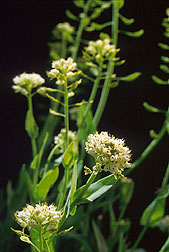This page has been archived and is being provided for reference purposes only. The page is no longer being updated, and therefore, links on the page may be invalid.
|
|
Using Plants to Clean Up Soil
By Sharon DurhamJanuary 23, 2007
Raising soil acidity to a pH level of 5.8 to 6 to help alpine pennycress absorb heavy metals from soil doesn't harm beneficial soil microbes, according to a recent study by Agricultural Research Service (ARS) scientists and cooperators.
The researchers have been conducting ongoing studies on using alpine pennycress (Thlaspi caerulescens) to remove cadmium and other heavy metals as part of a soil remediation process known as phytoextraction. Previously, they found that lowering the pH helped the plant remove toxic metals, but they were concerned that increasing soil acidity too much could harm beneficial soil microbes.
ARS agronomist Rufus Chaney, with the Environmental Management and Byproduct Utilization Laboratory, Beltsville, Md., has been a leader in using metal-accumulating plants to clean contaminated soil. He and others have shown that T. caerulescens can concentrate up to about 8,000 parts per million of toxic cadmium in its leaves.
Harvesting the aboveground vegetation annually makes it possible to reduce the concentration of cadmium in soil to safe levels in three to 10 years. Phytoextraction costs about $250 to $1,000 per acre per year, while the alternative clean-up method—removal and replacement with clean soil—costs about $1 million per acre.
The University of Maryland filed a patent on the use of T. caerulescens for the phytoextraction of cadmium in 2000, with Chaney as a cooperator. A patent for the process was granted in 2006 in the United States and Australia. No other similar technologies currently exist for remediation of cadmium-contaminated soils using plants.
To measure how pH affects soil microbes, Chaney and University of Maryland colleagues Shengchun Wang and Scott Angle adjusted two smelter-contaminated, high-metals soils to a range of pH levels, grew T. caerulescens in them for six months, and then analyzed soil microbe populations and activity. Then they adjusted the soils back to normal pH levels and incubated them for six months, to see if previously observed reductions in microbes persisted under normal soil management.
The scientists found that if the soil pH was adjusted no lower than that needed to maximize annual cadmium removal—a pH of about 5.8 to 6—there was no lasting adverse effect on soil microbes. And in both test soils, T. caerulescens tended to protect the soil microbes, compared to unplanted soils at the same pH levels.
ARS is the U.S. Department of Agriculture's chief scientific research agency.

